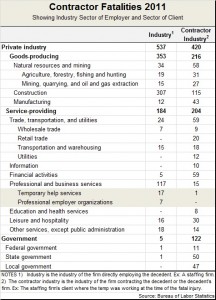When OSHA announced this spring it would be stepping up its enforcement at worksites using temps, it singled out staffing agencies for special attention.
A memo to OSHA’s regional administrators directed them to have their field inspectors “determine within the scope of their inspections whether any employees are temporary workers and whether any of the identified temporary employees are exposed to a violative condition.”
“For the purposes of this memorandum,” wrote Thomas Galassi, OSHA director of enforcement programs, “temporary workers are those supplied to a host employer and paid by a staffing agency.”
In the memo, he says the enforcement initiative was prompted by “a series of reports of temporary workers suffering fatal injuries during the first days on a job.”
Galassi, however, cites but a single fatal case of a temp supplied by a staffing agency. The only specific data the agency offers is a compilation of fatal incidents in 2011 prepared by the Bureau of Labor Statistics, showing that out of 542 fatalities involving contract workers that year (the most recent for which complete data is available), only 17 were employees of a staffing agency. Nine others were employed by a professional employer organization.
(OSHA refers to temporary workers, while the BLS data it references in an April 29th press release, includes contractors, who may be full-time workers of one firm, but working at a job site controlled by another.)
Why is the Occupational Safety and Health Administration focusing so intently on staffing agencies?
After several weeks of email exchanges, an agency spokeswoman didn’t specifically answer that question. What she said instead was:
OSHA is concerned about the safety and health of all workers, contingent and otherwise, but as outlined in our April 29, 2013 memorandum, for the purposes of our new initiative, “temporary worker” includes those who are working under a host employer/staffing agency employment structure…
As part of its overall effort, OSHA is reaching out to the American Staffing Association and OSHA Alliance partners that employ temporary workers to disseminate information and assistance, as well as to gather industry “best practices.”
Stephen Dwyer, ASA’s general counsel and spokesman on this issue, said the staffing agency focus is “A valid  question OSHA could be asked and should be asked.” However, he said that while the staffing industry “has had a very, very good record,” even a single fatality among its workers is too many.
question OSHA could be asked and should be asked.” However, he said that while the staffing industry “has had a very, very good record,” even a single fatality among its workers is too many.
“Regardless of the incident rate,” he said, “This has been a priority of the ASA.”
Well before OSHA first raised an alarm, ASA formed a safety committee to develop and promulgate safety best practice and offer assistance to staffing firms and outside agencies. Dwyer said the ASA met with OSHA representatives in March, before the latest initiative was announced, and will host a webinar July 18 on employee safety practices and the stepped up OSHA enforcement program.
“From our perspective, there is still work to do,” he said.
The BLS report cited by OSHA points out that almost one in four fatalities involved contractors working for government. Private construction contractors accounted for another 21%. The report breaks down the fatalities in two key ways:
- The industry of the employer that contracted them and in which the temp was working at the time of the injury or incident that lead to the death;
- The industry sector that employed the contractor.
Supplemental data provided by the BLS in response to my request, offers a far more detailed look at the fatalities, including the nature of the injury, location, the type of work being performed at the time, and what caused the fatal injury.
It isn’t possible to tell from the compilation how the 17 staffing agency employees were killed. But most of the accidents involved falls, traffic and pedestrian accidents (typically in a work zone), or being struck by an object. There were 19 homicides.
Although OSHA defines temporary workers as those supplied by a staffing agency, the BLS definition is much broader and includes workers of a contractor working at another employer’s site. The BLS report specifically notes that its definition for the purposes of its report “is not the same as the definition used by the Occupational Safety and Health Administration (OSHA) for recordkeeping purposes.”
BLS Economist Stephen Pegula provided examples of situations covered by its Census of Fatal Occupational Injuries.
In addition to many workers employed by temporary help services and professional employer organizations, the CFOI definition of contractors includes workers like:
- Construction workers who are subcontracted by another firm and working at a site where the other firm exercises overall responsibility for the operations.
- Elevator repair workers employed by a maintenance firm but working offsite at another business.
- Landscapers working at the site of another business.
- Security guards employed by a security firm but working at a restaurant, bar, or arena.
